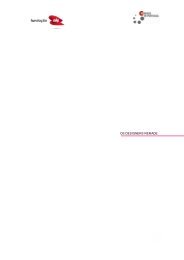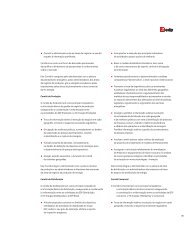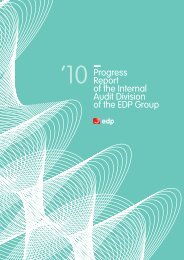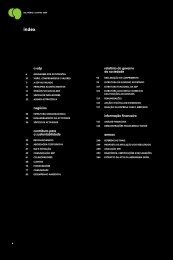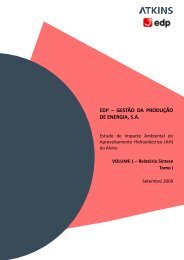Annual Report - EDP
Annual Report - EDP
Annual Report - EDP
- No tags were found...
Create successful ePaper yourself
Turn your PDF publications into a flip-book with our unique Google optimized e-Paper software.
: strategic framework :Reconversion of thePortuguese economycontinues to weight on theeconomic activity evolutionDuring 2012 the Portuguese economy contracted3.2%, in a context marked by the prosecutionof the adjustment process that operates underthe Economic Adjustment Programme (PAE)which imposes rationalization measures in publicfinances and structural reforms. Although thesemeasures are essential to provide a sustainablefinancial and economic base for Portugal, in theshort term, they generate adverse effects on theeconomic activity progression.Domestically, the budget consolidation effortembodied in the public spending reduction andthe increase of taxation, along with the shortageof financing and the high debt costs, resultedin a strong reduction of private consumptionand investment. This circumstance implied anexponential increase in the number of bankruptedcompanies and in unemployment, with aspecial incidence in the non-tradable assetsand services sector, along with a recessionspiral which resulted in an unprecedentedcontraction of internal demand. However, thedomestic weakness was mitigated by the notableperformance of exports, which beneficiated froma more favourable external conjuncture and fromexpressive competitive gains associated to thereduction of labour unitary costs. These events,associated with a strong reduction of importsresulted in an improvement of the Portuguesebalance of payments.PORTUGAL (REAL GDP, INFLATIONAND UNEMPLOYMENT RATE)0-1-2-3-41Q11 2Q11 3Q11 4Q11 1Q12 2Q12 3Q12 4Q12REAL GDP (YoY % CHANGE)UNEMPLOYMENT RATE (%)HARMONIZED INFLATION RATE (%)<strong>EDP</strong> - <strong>Annual</strong> <strong>Report</strong> 2012201612840Source: BloombergSpain goes back intorecessionAfter the economic activity contraction occurredbetween 2009-2010, the fourth biggest economyin the euro area went back into recession in2012, presenting a significant GDP change,estimated in -1.4%. In the centre of the Spanisheconomy weakness is the housing bubble,whose consequences continue to establisha vicious circle between the weak internaldemand, the unemployment rate, the instabilityof the banking system and the uncontrolledpublic finances. Indeed, the sharp decline of theconstruction industry and its related activities,unleashed a contraction of private consumptionand of investments along with a decrease oftax revenues and a substantial increase of thelevel of impairments in the banking industry.As a result, the unemployment rate rose tolevels higher than a quarter of the total activepopulation, which in turn, exacerbated thepressure against the domestic demand alongwith an increase of the government socialspending and a weakness of the credit institutionsbalances. The fast degradation of the economicand financial conjecture led to an increase ofinternational investor’s risk aversion againstSpanish assets, placing the country under thethreat of a generalized insolvency, which only didnot happened due to the timely intervention of theEuropean authorities.SPAIN (REAL GDP, INFLATIONAND UNEMPLOYMENT RATE)10-1-21Q11 2Q11 3Q11 4Q11 1Q12 2Q12 3Q12 4Q12REAL GDP (YoY % CHANGE)UNEMPLOYMENT RATE (%)HARMONIZED INFLATION RATE (%)PUBLIC DEFICIT (% OF GDP)4.49.45.0258.04.56.02824201612840Source: Bloomberg2011 2012 (e) 2013 (p) 2014 (p)PORTUGAL SPAIN Source: European ComissionBrazilian economy losesstrength in 2012The economic reforms undertaken during thelast years and the fast recovery of raw materialprices, after its fall subsequent to the financialinstability of 2008, enabled the Brazilian economyto present during the years after the financialand economic crisis a very satisfactory growthrate. However the international trade slowdownand the more restrictive monetary policies thattook place in 2011, determined a loss of ground inthe 2012 economic activity, backed up in a GDPgrowth estimation of about 1.5%, which is almosthalf of the rate presented in the previous year.Regarding the external position, the deteriorationof competitiveness brought an internal balance ofpayments contradicting the trend registered in theprevious years.This set of circumstances, prompted an energeticresponse by the economic policy authorities.Respecting the monetary policy, besides initiatingregular interventions in the foreign exchangemarket, with the objective of depreciatingthe Brazilian Real, the Central Bank of Brazilreduced the Selic tax from 12.5% to an historicalminimum of 7.25%. Concerning the budget andtaxation policies, the government announcedinfrastructure construction plans along with thecontinuation of the previous policy of rapid wagesgrowth and the implementation of tariffs aiming atprotecting the Brazilian industrial sector.In this context of marked economy’s loss ofground, the Brazilian stock index presented lowerreturns when compared to its peers. Equally, theBrazilian Real depreciated strongly, contradictingthe emerging economies’ general positiveperformance in the forex market.BRAZIL (REAL GDP, INFLATIONAND UNEMPLOYMENT RATE)5432101Q11 2Q11 3Q11 4Q11 1Q12 2Q12 3Q12 4Q12REAL GDP (YoY % CHANGE)UNEMPLOYMENT RATE (%)INFLATION RATE (%)2.56.4840Source: Bloomberg







